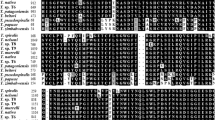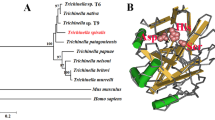Abstract
Serpins represent one of the most diverse families of serine protease inhibitors. Despite their complexity, they are virtually found in all organisms and play an important role in homeostasis processes such as blood coagulation, inflammation, fibrinolysis, immune responses, chromatin condensation, tumor suppression, and apoptosis. There has recently been particular interest in studying serpin functions in infection and inflammation, especially since more serpins from parasites have been identified and characterized. Among helminths, Trichinella spiralis is one of the few parasites with an extremely strong ability to induce host immune suppression. Previous studies show that serpins are present in Trichinella and are expressed differentially at different parasite stages. More interesting, there is evidence of a recombinant serpin from Trichinella pseudospiralis that alters macrophage polarization in vitro. This finding could be relevant to comprehend the modulation process of the immune response. We expressed Tsp_01570, a putative serpin gene from Trichinella spiralis, in the eukaryotic system Pichia pastoris SMD1168H and evaluated its presence at different parasite stages, finding the serine protease inhibitor in the crude extract of adult worms. The effect of recombinant serpin on THP-1 cells was tested by quantification of IL-12p40, TNF-α, IL-4, and IL-10 cytokines released by ELISA. We also evaluated the expression of the M1 markers, CCR7 and CD86, and the M2 markers, CD163 and CD206, by immunofluorescence staining. This study represents the first insight in elucidating the importance of serpin Tsp_01570 as a potential molecular modulator.






Similar content being viewed by others
Data availability
Relevant raw data will be available at request to any researcher wishing to use them for non-commercial purposes. Relevant datasets will be deposited in publicly available repositories.
References
Antunes AA et al (2018) Thermodynamic analysis of Kex2 activity: the acylation and deacylation steps are potassium-and substrate-dependent. Biophys Chem 235:29–39
Bao J, Pan G, Poncz M, Wei J, Ran M, Zhou Z (2018) Serpin Functions in Host-Pathogen Interactions Peerj 6:e4557
Bruschi F (2002) The immune response to the parasitic nematode Trichinella and the ways to escape it. From experimental studies to implications for human infection. Curr Drug Targets Immune Endocr Metabol Disord 2(3):269–280
Coutinho ML et al (2020) Rhipicephalus microplus serpins interfere with host immune responses by specifically modulating mast cells and lymphocytes. Ticks Tick Borne Dis 11(4):101425
García-González G, Ascacio-Martínez JÁ, Hernández-Bello R, González GM, Palma-Nicolás JP (2021) Expression of recombinant protease MarP from Mycobacterium tuberculosis in Pichia pastoris and its effect on human monocytes. Biotechnol Lett 43(9):1787–1798
Gatto M et al (2013) Serpins, immunity and autoimmunity: old molecules, new functions. Clin Rev Allergy Immunol 45(2):267–280
Gettins PG (2002) Serpin structure, mechanism, and function. Chem Rev 102(12):4751–4804
Goulas T et al (2017) A structure-derived snap-trap mechanism of a multispecific serpin from the dysbiotic human oral microbiome. J Biol Chem 292(26):10883–10898
Heit C et al (2013) Update of the human and mouse SERPIN gene superfamily. Hum Genomics 7(1):1–14
Huntington J (2011) Serpin structure, function and dysfunction. J Thromb Haemost 9:26–34
Jönsson LJ, Saloheimo M, Penttilä M (1997) Laccase from the white-rot fungus Trametes versicolor: cDNA cloning of lcc1 and expression in Pichia pastoris. Curr Genet 32(6):425–430
Kang SA et al (2012) Alteration of helper T-cell related cytokine production in splenocytes during Trichinella spiralis infection. Vet Parasitol 186(3–4):319–327
Ming L et al (2016) Invasion by Trichinella spiralis infective larvae affects the levels of inflammatory cytokines in intestinal epithelial cells in vitro. Exp Parasitol 170:220–226
Molehin AJ, Gobert GN, McMANUS DP (2012) Serine protease inhibitors of parasitic helminths. Parasitology 139(6):681–695
Nagano I, Wu Z, Nakada T, Matsuo A, Takahashi Y (2001) Molecular cloning and characterization of a serine proteinase inhibitor from Trichinella spiralis. Parasitology 123(1):77–83
Sreekrishna K, Kropp KE (1996) Pichia pastoris. In: Wolf K (ed) Nonconventional yeasts in biotechnology. Springer, Berlin, pp 203–253
Xu N et al (2017) Recombinant Trichinella pseudospiralis serine protease inhibitors alter macrophage polarization in vitro. Front Microbiol 8:1834. https://doi.org/10.3389/fmicb.2017.01834
Zhang Z et al (2016) High-level expression and characterization of two serine protease inhibitors from Trichinella spiralis. Vet Parasitol 219:34–39
Zhuang H, Han S, Lu L, Reeves WH (2021) Myxomavirus serpin alters macrophage function and prevents diffuse alveolar hemorrhage in pristane-induced lupus. Clin Immunol 229:108764
Acknowledgements
Cortez-de-la-Fuente LJ was a student under a CONACyT National Scholarship for Doctoral Programs (CVU 557895). We also thank Dr. Sergio Lozano Rodríguez for proofreading this manuscript.
Funding
The Mexican National Council for Science and Technology (CONACyT) supported this work through the approval of a Grant application to JPPN (Number 238125) and RHB (Number 255173) from the “Fondo Sectorial de Investigación para la Educación” (SEP-CONACyT).
Author information
Authors and Affiliations
Contributions
José Prisco Palma-Nicolás contributed to the conceptualization, methodology, supervision, resources, project administration and funding acquisition, and writing—review and editing. Luis Jesús Cortez-de-la-Fuente contributed to the investigation, conceptualization, methodology, formal analysis, and writing—original draft. Gerardo García-González contributed to the methodology, investigation, and formal analysis. Romel Hernández-Bello contributed to the resource acquisition, methodology, and formal analysis. Gloria M. González contributed to the supervision, resource acquisition, and writing—review and editing.
Corresponding author
Ethics declarations
Ethical approval
Animal care and protocols were evaluated and approved by the Ethics and Research Committee and the Institutional Committee for the Care and Use of Laboratory Animals, School of Medicine, Universidad Autónoma de Nuevo Leon (protocol number: MB19-00001). All experiments performed in this study followed the official Mexican standard (NOM-062-ZOO-1999), which is in strict accordance with the recommendations in the Guide for the Care and Use of Laboratory Animals of the National Institutes of Health (NIH) of the United States.
Consent to participate
It is not applicable.
Consent to publish
It is not applicable.
Conflicts of interest
The authors have no conflicting interests to declare.
Additional information
Section Editor: Abdul Jabbar
Publisher's note
Springer Nature remains neutral with regard to jurisdictional claims in published maps and institutional affiliations.
Supplementary information
Below is the link to the electronic supplementary material.
Rights and permissions
Springer Nature or its licensor (e.g. a society or other partner) holds exclusive rights to this article under a publishing agreement with the author(s) or other rightsholder(s); author self-archiving of the accepted manuscript version of this article is solely governed by the terms of such publishing agreement and applicable law.
About this article
Cite this article
Cortez-de-la-Fuente, L.J., García-González, G., Hernández-Bello, R. et al. Expression of Trichinella spiralis serpin Tsp_01570 in Pichia pastoris: a first insight of its biomodulatory activity. Parasitol Res 122, 245–255 (2023). https://doi.org/10.1007/s00436-022-07723-0
Received:
Accepted:
Published:
Issue Date:
DOI: https://doi.org/10.1007/s00436-022-07723-0




